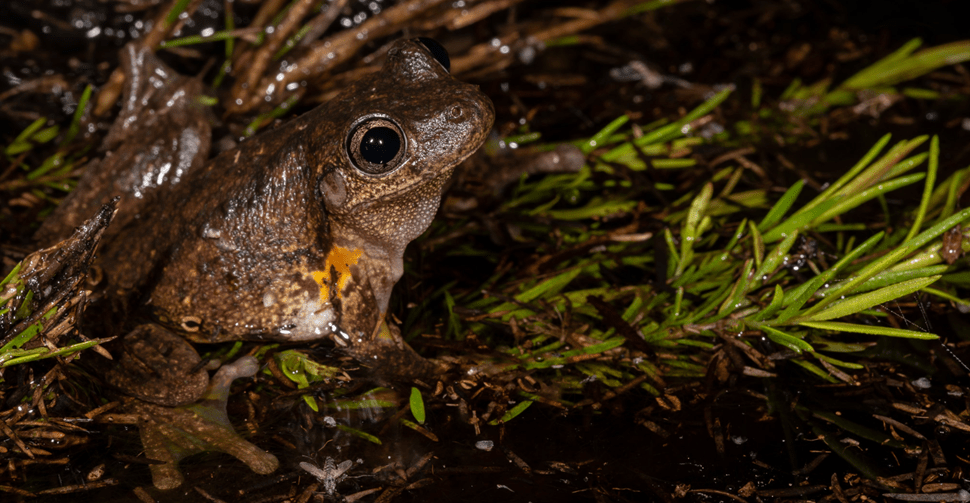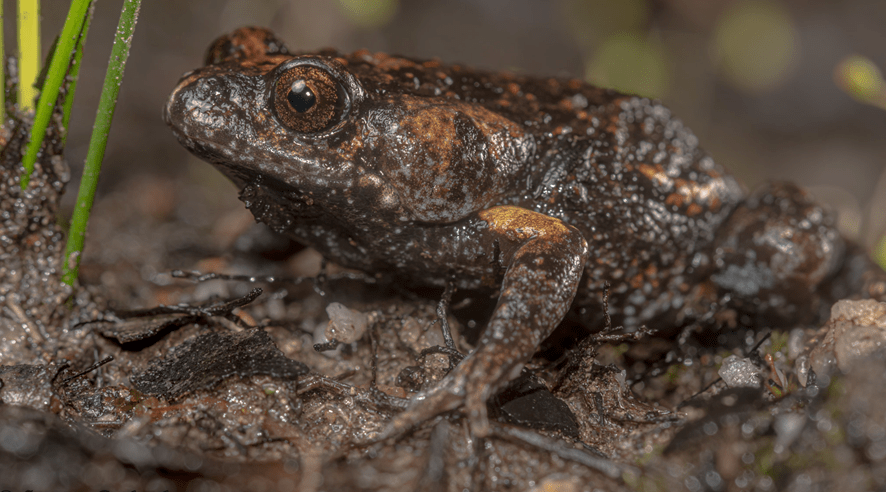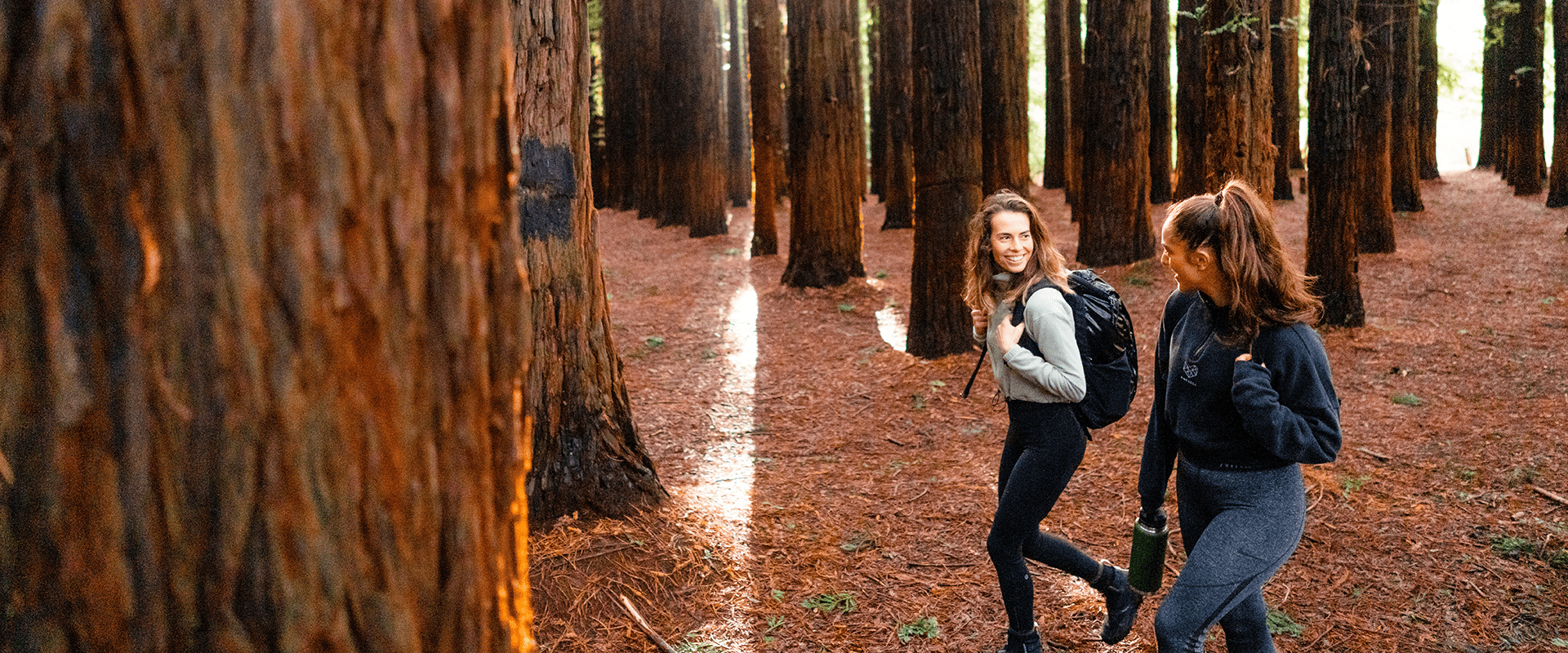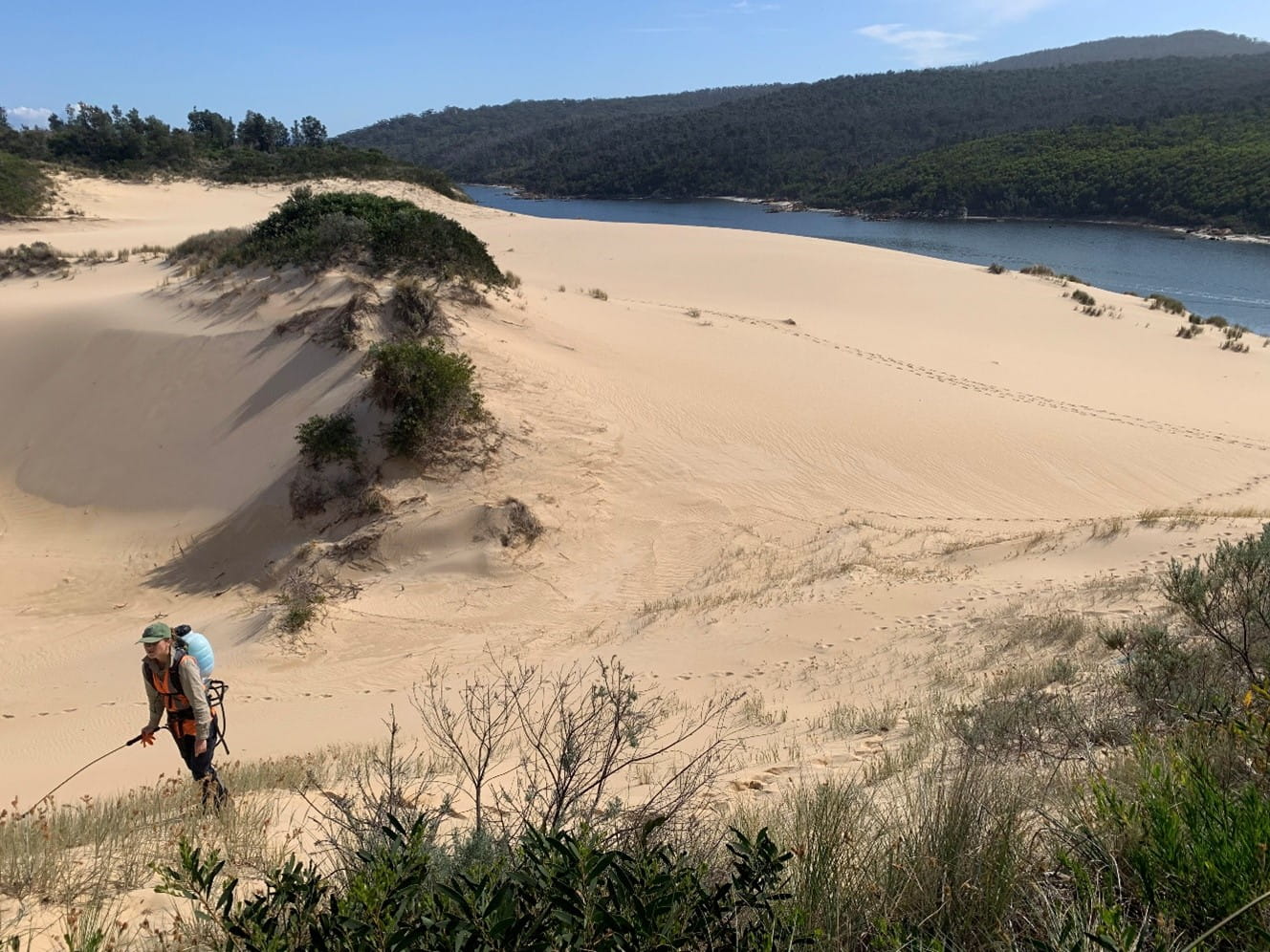A croak above the rest: How you can help the elusive Growling Grass Frog in Wilsons Prom
Monday 11 December, 2023
Key points
-
The vulnerably listed Growling Grass Frog (Litoria raniformis) has been sighted in Wilsons Promontory National Park but the range and status of their population is not well understood.
-
Parks Victoria is partnering with the Australian Museum and their FrogID app to work with citizen scientists/members of the public to find Growling Grass frogs and other frog species, which may be new to the Prom.
-
This work is part of the ongoing "Prom Sanctuary Project", which will transform Wilsons Promontory National Park into the largest conservation sanctuary in Victoria.
This "slimy-boi" (a Growling Grass Frog) is an ambush predator, sitting and waiting for prey to come past. Growling Grass frogs have been known to eat other frog species. Image credit: Jeremy Tscharke.
Citizen science has led to some of the most remarkable discoveries in the state of Victoria. Farmers surveying the Moe-to-Bunyip railway line in Warragul in the 1870s described an animal, buried underground with flesh soft to the touch, as a “metre-long snake”. After sending remains to the University of Melbourne, they realised it was in fact a worm, and one of the first western references of a Giant Gippsland earthworm (Megascolides australis).
Now, we’re asking for your help as part of a Prom Sanctuary project summer initiative – we're asking you to keep an “ear” out for some of our froggy friends, and for one of the most iconic frogs in Victoria: the Growling Grass Frog (Litoria raniformis).
The Growling Grass frog has a characteristically slow and deep call that sounds like its namesake; a guttural growl. Video credit: the Victorian National Parks Association.
Jeremy Tscharke is an ecological planner based at Wilsons Promontory National Park, which is part of a rich and diverse Aboriginal cultural landscape. Jeremy has extensive experience conducting fieldwork across the Prom and leading the frog and reptile surveys at the Prom for Parks Victoria. “The endangered Growling Grass Frog was once considered extremely common (throughout Victoria) with reports of masses of them on roads at night, proudly belting their deafening choruses. Their skin colour/tone can vary considerably, from a bright emerald green to a dull brown. They are one of the largest frog species in Victoria,” Jeremy says.
“Their populations have suffered considerably in the past 30 years. This species has been recorded at a few locations in and around the Prom, but is listed as threatened in Victoria due to climate change pressures, including altered water flow, increased feral animal predation (from feral cats and foxes) and an introduced disease called Chytrid fungus, which is responsible for widespread collapse of frog populations in Australia.”
“It’s a reminder to never take our native animals and plants for granted – even those considered ‘common’ are susceptible to the impacts of climate change.”
Chytrid fungus (Batrachochytrium dendrobatidis) is implicated in the mass deaths and extinctions of numerous frog species worldwide and in Australia since the early 1990s. Understanding the origin of this fungus has been difficult, but it is most likely tied to the global trade of frogs throughout the 20th century. This fungus invades the surface layers of a frog’s skin and disrupts their ability to thermoregulate their body. It is thought to be one of the primary reasons for many local extinctions of Growling Grass Frogs across Victoria. But, by utilising your phone this summer, you can help us catalogue their call and location at the Prom, along with the distinct and varied calls of their froggy peers, through the Australian Museum’s simple-to-use and free to download app: FrogID.
Your citizen science will help contribute to the first comprehensive database of frog populations at the Prom.
Australian Museum's Frog ID app program
FrogID aims to catalogue a nation-wide database of frog calls recorded by citizen scientists. The app logs a unique time-stamped audio recording, which helps identify the species. Why a recording? Well, a frog’s call is one of the most accurate ways to differentiate it from other species.
By utilising FrogID, the potential to find new species or populations of frogs in Wilsons Promontory is high, according to Jeremy. “Reptiles and amphibians are yet to be comprehensively surveyed at the Prom, with very few historic survey efforts known or formally recorded. This opens up an exciting opportunity and strong possibility, as part of our community call-out, to find a frog species or population that is new to the Prom.”
The information provided through the app will help us work out the diversity of frogs, and importantly, where frogs are not being recorded. Frogs can be a bio-indicator of ecosystem health, and declining frog populations across numerous species can also indicate predation by introduced pests, which includes larger predators such as foxes or cats. Knowing more about them may help us better identify and respond to potential threats at the Prom.

Peron's Tree Frog (Litoria peronii) have never been sighted or heard before in Wilsons Prom. Are they hiding in plain sight? Image credit: Jeremy Tscharke

If a population of Martin's toadlet (Uperoleia martini) is found at Wilsons Prom, it would represent the southernmost occurrence for this species. Image credit: Jeremy Tscharke
How you can help
1. Download the FrogID app on your phone and create a profile.
2. Visit Wilsons Promontory National Park. Stick to paths and when you hear what you think is a frog call, whip out your phone and record it. The recording needs to at least 20 seconds long.
3. Submit the recording. You don’t even have to know which frog you’re listening to, as verified froggy scientists will gather your data and identify which species of frog you've captured! This information is then accessible to Parks Victoria scientists who can use the data to inform their work.
This habitat in Wilsons Prom represents prime real-estate for many frog species. Image credit: Jeremy Tscharke
The Prom Sanctuary project
The Prom is situated at the southernmost point of mainland Australia and is naturally sheltered from the dramatic impacts of climate change. Through the Prom Sanctuary project, Wilsons Promontory National Park will become a 50, 000-hectare climate change safe haven, where Victoria’s rich wildlife and habitats are freed from the pressures of introduced predators and pests.
Citizen science is a powerful tool. This summer, members of the public can help catalogue Growling Grass frogs and even new frog species hiding in the Prom. “We hope to see strong community participation – it will contribute significantly to our goal of understanding the number of amphibian populations and their distribution around the Prom. Every record is important and helps us understand where targeted conservation efforts are needed, such as providing extra protections against Chytrid fungus, feral animal predation or better targeting our management of over abundant vegetation that could cause shading and cooling of waterways,” Jeremy says.
The data collected by visitors and local community will support Parks Victoria rangers and scientists, who will be conducting overnight surveys at a variety of locations across the Prom that could support froggy activity.
There are a number of other frog species to keep an “ear” out for, check out the list below and click on their calls to find out what they sound like.
The Frogs of Wilsons Prom
The Common Eastern froglet can be found where-ever freshwater is located. Image credit: Museums Victoria
1) Common Eastern Froglet (Crinia signifera)
Status: Least Concern
Body size: About the size of a 50-cent coin (3cm in length)
Call: 'crick-crick-crick-crick-crick'
Click the play button to hear the Common Eastern Froglet
Also known as a Pobblebonk, these frogs are known to dig themselves into the ground and emerge when conditions are moist. Image credit: Peter Robertson
2) Eastern Banjo Frog (Limnodynastes dumerilii)
Status: Least Concern
Body size: Slightly bigger than a tennis ball (7.5 cm in length)
Call: A series of "bonks" sounding similar to the plucking of banjo strings
Click the play button to hear the Eastern Banjo Frog
The tadpoles of this species (like many frogs) are significantly longer than the adults. Image credit: Museums Victoria
3) Striped Marsh Frog (Limnodynastes peronii)
Status: Least Concern
Body size: Slightly bigger than a tennis ball (7.5 cm in length)
Call: Call a continuously repeated "tock", similar to a clucking hen
Click the play button to hear the Striped Marsh Frog
This frog is found through eastern Australia and extends through to Tasmania. This population overlap is indicative of a time when Tasmania was joined to the mainland over 12,000 years ago. Image credit: Museums Victoria
4) Spotted Marsh Frog (Limnodynastes tasmaniensis)
Status: Least Concern
Body size: Slightly smaller than a USB stick (up to 4.5 cm)
Call: Varies geographically, ranging from a staccato machine gun sounding burst to a single 'Tok' sound
Click the play button to hear the Spotted Marsh Frog
These frogs are fantastic predators, capable of catching prey (such as insects) mid-flight. Image credit: Museums Victoria
5) Southern Brown Tree Frog (Litoria ewingii)
Status: Least Concern
Body size: About the length of a AA battery (up to 4.5 cm)
Call: A fast, high pitched "creeee creee creeee creeee"
Click the play button to hear the Southern Brown Tree Frog
This frog has two known subspecies, one of which is only found in the alpine regions of the Great Dividing Range. Image credit: Museums Victoria.
6) Whistling Tree Frog (Litoria verreauxii)
Status: Least Concern
Body size: About the size of a 50-cent coin (up to 3.5cm long)
Call: A fast ‘reeet reeet reeet’
Click the play button to hear the Whistling Tree Frog












